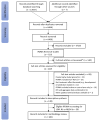Nonlinear effects and effect modification at the participant-level in IPD meta-analysis part 1: analysis methods are often substandard
- PMID: 37146661
- PMCID: PMC7616832
- DOI: 10.1016/j.jclinepi.2023.04.013
Nonlinear effects and effect modification at the participant-level in IPD meta-analysis part 1: analysis methods are often substandard
Abstract
Objectives: To review analysis methods used for linear effect modification (LEM), nonlinear covariate-outcome associations (NL) and nonlinear effect modification (NLEM) at the participant-level in individual participant data meta-analysis (IPDMA).
Study design and setting: We searched Medline, Embase, Web of Science, Scopus, PsycINFO and the Cochrane Library to identify IPDMA of randomized controlled trials (PROSPERO CRD42019126768). We investigated if and how IPDMA examined LEM, NL and NLEM, including whether aggregation bias was addressed and if power was considered.
Results: We screened 6,466 records, randomly sampled 207 and identified 100 IPDMA of LEM, NL or NLEM. Power for LEM was calculated a priori in 3 IPDMA. Of 100 IPDMA, 94 analyzed LEM, 4 NLEM and 8 NL. One-stage models were favoured for all three (56%, 100%, 50%, respectively). Two-stage models were used in 15%, 0% and 25% of IPDMA with unclear descriptions in 30%, 0% and 25%, respectively. Only 12% of one-stage LEM and NLEM IPDMA provided sufficient detail to confirm they had addressed aggregation bias.
Conclusion: Investigation of effect modification at the participant-level is common in IPDMA projects, but methods are often open to bias or lack detailed descriptions. Nonlinearity of continuous covariates and power of IPDMA are rarely assessed.
Keywords: Effect modification; Fractional polynomials; Individual participant data meta-analysis; Interaction; Nonlinear; One- and two-stage models; Restricted cubic splines; Sample size.
Copyright © 2023 The Authors. Published by Elsevier Inc. All rights reserved.
Conflict of interest statement
Declaration of Competing Interest The authors declare the following financial interests/personal relationships which may be considered as potential competing interests.
Figures



References
-
- Riley RD, Debray TPA, Fisher D, Hattle M, Marlin N, Hoogland J, et al. Individual participant data meta-analysis to examine interactions between treatment effect and participant-level covariates: statistical recommendations for conduct and planning. Stat Med. 2020;39:2115–37. doi: 10.1002/sim.8516. - DOI - PMC - PubMed
-
- Tierney JF, Stewart LA, Clarke M. In: Cochrane handbook for systematic reviews of interventions version 6 3. Higgins JPT, Chandler J, Cumpston M, Li T, Page MJ, Welch VA, editors. Cochrane; 2022. [Accessed June 12, 2023]. Chapter 26: individual participant data. (updated February 2022) Available at www.training.cochrane.org/handbook.
-
- Schandelmaier S, Briel M, Varadhan R, Schmid CH, Devasenapathy N, Hayward RA, et al. Development of the instrument to assess the credibility of effect modification analyses (ICEMAN) in randomized controlled trials and meta-analyses. CMAJ. 2020;192(32):E901–6. doi: 10.1503/cmaj.200077. - DOI - PMC - PubMed
-
- Leijten P, Scott S, Landau S, Harris V, Mann J, Hutchings J, et al. Individual participant data meta-analysis: impact of conduct problem severity, comorbid attention-deficit/hyperactivity disorder and emotional problems, and maternal depression on parenting program effects. J Am Acad Child Adolesc Psychiatry. 2020;59(8):933–43. - PubMed
Publication types
MeSH terms
Grants and funding
LinkOut - more resources
Full Text Sources

